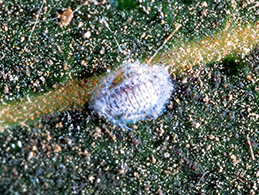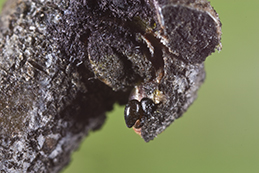Hackberry woolly aphid—Shivaphis celti
The pest, also named Asian woolly hackberry aphid (Aphididae), sucks phloem sap from Celtis spp. leaves. It is especially abundant on Chinese hackberry, Celtis sinensis.
Identification
Check for the insects to confirm that the cause of honeydew is aphids. These aphids on green shoots and leaves occur beneath small, roundish, fuzzy, bluish or white waxy masses, each 1/10 inch in diameter or less. Their body is gray to whitish. Winged adults have distinct black borders along the forewing veins and their antennae have alternating dark and light bands.
Citricola scale, Coccus pseudomagnoliarum, is the only other honeydew-producing insect that infests hackberry at annoying levels in California. It is most common in the Central Valley on citrus and hackberry. The scales are immobile most of their life and are easily overlooked. On leaves, the first-instar scales are often translucent and barely visible with the naked eye. Older scales occur on twigs where their mottled gray to brown color blends in with bark.
Life cycle
The aphid overwinters on terminals as eggs that hatch in spring when the new leaves flush. Adults and nymphs can be abundant on leaves from spring through fall. Throughout most of the growing season, adult females (which may be winged or wingless) give birth to live young without mating. In the fall, a sexual generation of winged males and females is produced. The aphids mate and females lay the overwintering eggs on bud scales. The aphid has multiple generations per year.
Damage
The aphid sucks phloem sap and produces copious honeydew and wax on hackberry leaves. The honeydew and wax excreted by adults and nymphs typically become most abundant and bothersome during late summer.
Solutions
Insecticides apparently are not warranted to protect the health or survival of aphid-infested hackberries. If the excretions are intolerable, foliage can be sprayed with horticultural oil. Alternatively, hackberry branch terminals can be sprayed with oil after leaves drop, during the dormant season or delayed-dormant season, to kill the overwintering eggs.
On large trees, the most practical control is to apply systemic insecticide according to label directions, preferably as a soil application or bark spray during late winter or spring. Avoid injecting or implanting pesticides or other materials into hackberry trunks or roots. Chinese hackberry are susceptible to an unexplained, tree-killing malady; the cause may be a vascular wilt pathogen mechanically spread by unsterilized tools that contact internal parts of multiple hackberry trees, such as tools used to prune trees or inject them with chemicals. See Pest Notes: Hackberry Woolly Aphid for more information.
|

Wax-covered aphids and honeydew

Adult hackberry woolly aphid

Nymph excreting a waxy cover

Aphid eggs (lower center) on a bud
|


